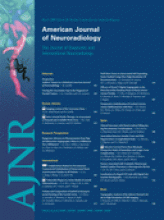Research ArticleNeurointervention
Open Access
Vulnerable Plaque in a Swine Model of Carotid Atherosclerosis
Z.-S. Shi, L. Feng, X. He, A. Ishii, J. Goldstine, H.V. Vinters and F. Viñuela
American Journal of Neuroradiology March 2009, 30 (3) 469-472; DOI: https://doi.org/10.3174/ajnr.A1410
Z.-S. Shi
L. Feng
X. He
A. Ishii
J. Goldstine
H.V. Vinters

References
- ↵Altaf N, MacSweeney ST, Gladman J, et al. Carotid intraplaque hemorrhage predicts recurrent symptoms in patients with high-grade carotid stenosis. Stroke 2007;38:1633–35
- Mathiesen EB, Bonaa KH, Joakimsen O. Echolucent plaques are associated with high risk of ischemic cerebrovascular events in carotid stenosis: the tromso study. Circulation 2001;103:2171–75
- ↵Takaya N, Yuan C, Chu B, et al. Association between carotid plaque characteristics and subsequent ischemic cerebrovascular events: a prospective assessment with MRI–initial results. Stroke 2006;37:818–23
- ↵Johnson J, Carson K, Williams H, et al. Plaque rupture after short periods of fat feeding in the apolipoprotein E-knockout mouse: model characterization and effects of pravastatin treatment. Circulation 2005;111:1422–30
- Johnson JL, Jackson CL. Atherosclerotic plaque rupture in the apolipoprotein E knockout mouse. Atherosclerosis 2001;154:399–406
- ↵Sasaki T, Kuzuya M, Nakamura K, et al. A simple method of plaque rupture induction in apolipoprotein E-deficient mice. Arterioscler Thromb Vasc Biol 2006;26:1304–09
- ↵Schwartz SM, Galis ZS, Rosenfeld ME, et al. Plaque rupture in humans and mice. Arterioscler Thromb Vasc Biol 2007;27:705–13
- ↵Ishii A, Vinuela F, Murayama Y, et al. Swine model of carotid artery atherosclerosis: experimental induction by surgical partial ligation and dietary hypercholesterolemia. AJNR Am J Neuroradiol2006;27:1893–99
- ↵Pessin MS, Hinton RC, Davis KR, et al. Mechanisms of acute carotid stroke. Ann Neurol 1979;6:245–52
- Siebler M, Sitzer M, Steinmetz H. Detection of intracranial emboli in patients with symptomatic extracranial carotid artery disease. Stroke 1992;23:1652–54
- ↵Bamford J, Sandercock P, Dennis M, et al. Classification and natural history of clinically identifiable subtypes of cerebral infarction. Lancet 1991;337:1521–26
- ↵Stary HC, Chandler AB, Dinsmore RE, et al. A definition of advanced types of atherosclerotic lesions and a histological classification of atherosclerosis: a report from the Committee on Vascular Lesions of the Council on Arteriosclerosis, American Heart Association. Circulation 1995;92:1355–74
- ↵Naghavi M, Libby P, Falk E, et al. From vulnerable plaque to vulnerable patient: a call for new definitions and risk assessment strategies. Circulation 2003;108 (part I):1772–78
- ↵Fisher M, Paganini-Hill A, Martin A, et al. Carotid plaque pathology: thrombosis, ulceration, and stroke pathogenesis. Stroke 2005;36:253–57
- ↵Gal D, Rongione AJ, Slovenkai GA, et al. Atherosclerotic Yucatan microswine: an animal model with high-grade, fibrocalcific, nonfatty lesions suitable for testing catheter-based interventions. Am Heart J 1990;119:291–300
- ↵
- ↵Golledge J, Siew DA. Identifying the carotid “high risk” plaque: is it still a riddle wrapped up in an enigma? Eur J Vasc Endovasc Surg 2008;35:2–8. Epub 2007 Nov 5
In this issue
Advertisement
Z.-S. Shi, L. Feng, X. He, A. Ishii, J. Goldstine, H.V. Vinters, F. Viñuela
Vulnerable Plaque in a Swine Model of Carotid Atherosclerosis
American Journal of Neuroradiology Mar 2009, 30 (3) 469-472; DOI: 10.3174/ajnr.A1410
0 Responses
Jump to section
Related Articles
- No related articles found.
Cited By...
- Arterial wall injury and miRNA expression induced by stent retriever thrombectomy under stenotic conditions in a dog model
- Three-Dimensional Impedance Tomographic Mapping of Metabolically Active Endolumen
- Matrix metalloproteinase-9 expression in carotid atherosclerotic plaque and contrast-enhanced MRI in a swine model
- Overexpression of matrix metalloproteinase-9 is correlated with carotid intraplaque hemorrhage in a swine model
- Development of a Magnetic Resonance Imaging Protocol for the Characterization of Atherosclerotic Plaque by Using Vascular Cell Adhesion Molecule-1 and Apoptosis-Targeted Ultrasmall Superparamagnetic Iron Oxide Derivatives
- Plasma lipid profiling across species for the identification of optimal animal models of human dyslipidemia
This article has not yet been cited by articles in journals that are participating in Crossref Cited-by Linking.
More in this TOC Section
Similar Articles
Advertisement











